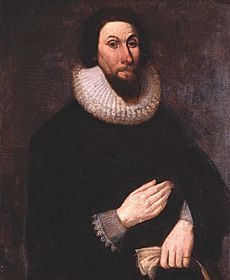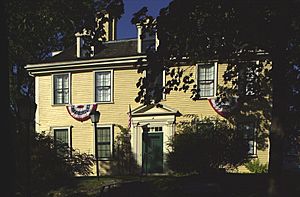Richard Bellingham facts for kids
Quick facts for kids
Richard Bellingham
|
|
|---|---|
| 8th, 16th, and 18th Governor of the Massachusetts Bay Colony | |
| In office 1641–1642 |
|
| Monarch | Charles I |
| Preceded by | Thomas Dudley |
| Succeeded by | John Winthrop |
| In office 1654–1655 |
|
| Monarch | The Protectorate |
| Preceded by | John Endecott |
| Succeeded by | John Endecott |
| In office 1665–1672 |
|
| Monarch | Charles II |
| Preceded by | John Endecott |
| Succeeded by | John Leverett |
| Personal details | |
| Born | c. 1592 Boston, Lincolnshire, England |
| Died | 7 December 1672 (aged 79–80) Boston, Massachusetts Bay Colony |
| Signature | |
Richard Bellingham (born around 1592 – died December 7, 1672) was an important leader in the early Massachusetts Bay Colony. He was a lawyer and served as the colony's governor many times. He was also the last person alive who had signed the colony's original official document, called the charter.
Before moving to the New World in 1634, Bellingham was a successful lawyer in England. He often had different political ideas than other leaders like John Winthrop. Bellingham believed more people should have the right to vote and help make laws. He also helped create the Massachusetts Body of Liberties, a set of laws that included many ideas similar to the later United States Bill of Rights.
Bellingham served as governor for ten years. Many of these years were during a sensitive time when King Charles II was closely watching how the colonies were run. Bellingham famously refused a direct order from the king to come to England. This action might have contributed to the colony's charter being taken away later in 1684.
He was married twice and had one son named Samuel. Richard Bellingham died in 1672. He left behind a large estate and a house in Boston. His will led to legal battles that lasted over 100 years. Bellingham is also mentioned in famous books like The Scarlet Letter by Nathaniel Hawthorne.
Contents
Richard Bellingham's Early Life
Richard Bellingham was born in Lincolnshire, England, around 1592. His family was quite wealthy. They lived in a large house called Bromby Wood. He studied law at Brasenose College, Oxford, starting in 1609.
In 1625, he became the top legal officer, called the Recorder, for the town of Boston. He held this job until 1633. He also represented Boston in the English Parliament in 1628 and 1629. Bellingham first married Elizabeth Backhouse. They had several children, but only their son Samuel lived to be an adult.
In 1628, Bellingham became an investor in the Massachusetts Bay Company. He was one of the people who signed the land grant for the company. His name is also on the official royal charter for the Massachusetts Bay Colony from 1629. In 1633, he quit his job as Recorder and started selling his properties. The next year, he sailed to the New World with his wife and son. Elizabeth died soon after they arrived in Boston, Massachusetts.
Life in the Massachusetts Bay Colony

When Bellingham arrived, he quickly became an important figure in the colony. He helped manage the affairs of Boston, including setting up Boston Common. He also bought the ferry service between Boston and Winnessimmett (now Chelsea). He owned a large house in Boston and a country home in Winnessimmett. A house he built in Chelsea in 1659, known as the Bellingham-Cary House, is still standing today.
For many years, Bellingham was elected to the colony's council of assistants. This group advised the governor and acted as a court. He also served several times as the colony's treasurer. He was first elected deputy governor in 1635. He became deputy governor again in 1640. In 1637, he was one of the judges who decided to banish Anne Hutchinson from the colony.
Historians say Bellingham was sometimes bold and argumentative. He and John Winthrop often disagreed on political issues. Bellingham also helped create the colony's first legal code, called the Massachusetts Body of Liberties. Winthrop did not like this idea and tried to stop it.
Bellingham's First Term as Governor
In 1641, Bellingham was elected governor for the first time. He ran against Winthrop. The Body of Liberties was officially adopted during his term. However, he served for only one year and was replaced by Winthrop in 1642.
Bellingham's defeat might have been partly due to his second marriage. He married Penelope Pelham, a young woman, without following all the usual steps. As governor, he refused to step down from his position to address the concerns. Winthrop described Bellingham's term as very difficult. He said Bellingham often disagreed with other leaders, which slowed down important work.
Dealing with Quakers

In 1650, Bellingham agreed with a court decision to ban a book that many Puritans thought was against their beliefs. Bellingham was elected governor again in 1654. He was re-elected every year from 1665 until his death. He served a total of ten years as governor and thirteen as deputy governor.
In 1656, while he was deputy governor, a ship carrying several Quakers arrived in Boston. Bellingham was in charge because Governor John Endecott was away. The Puritans did not like Quaker beliefs. So, Bellingham ordered that the Quakers stay on their ship. Their belongings were searched, and their religious books were destroyed. After five weeks, they were sent back to England.
During Endecott's time as governor, the rules against Quakers who returned to the colony became stricter. Eventually, the death penalty was put in place for those who kept coming back. Under these laws, four Quakers were put to death for returning after being banished. Later, the authorities realized the death penalty was not working well. The law was changed to less harsh punishments like branding and whipping.
English Restoration and Colonial Challenges
The 1640s and 1650s were a time of big changes in England. The English Civil War led to a new government without a king. Massachusetts generally supported this new government. But when Charles II became king again in 1660, all the colonies, especially Massachusetts, came under his close watch.
In 1661, King Charles II ordered that the persecution of Quakers stop. He also asked Massachusetts to change its laws to allow more people to vote and to be more tolerant of other Protestant religions. The colony, especially under Governor Endecott, resisted or ignored these demands. In 1664, King Charles sent royal officials to New England to make sure his demands were followed. Massachusetts was the most difficult colony, refusing most of the king's requests.
In 1666, King Charles ordered Bellingham, who was governor, and William Hathorne, a leader in the colony's court, to come to England. They were to explain the colony's behavior. This demand caused a big debate in the colony. Some people wanted to obey the king, while others wanted to resist him. Bellingham sided with those who wanted to resist.
The colony decided to send the king a letter instead. The letter questioned if the request truly came from the king. It also said the colony was loyal and had already explained why they could not obey. The leaders also tried to calm the king by sending a ship full of timber as a gift. King Charles was busy with a war and other problems in England, so he did not push the issue further until after Bellingham's death. However, the Massachusetts Bay Colony's charter was eventually taken away in 1684.
Death and Lasting Impact
Richard Bellingham died on December 7, 1672. He was the last person alive who had signed the colony's original charter. He was buried in Boston's Granary Burying Ground. His son Samuel and his second wife Penelope survived him.
His land in Winnessimmett became involved in legal battles that lasted over 100 years. These cases needed court decisions on both sides of the Atlantic Ocean. Bellingham's will set aside some of his properties for religious uses. However, his son challenged the will, and it was eventually overturned. The legal fights continued until 1785.
The town of Bellingham, Massachusetts is named after him. Several places in Chelsea, including a square, a street, and a hill, also bear his name.

Bellingham appears as a character in Nathaniel Hawthorne's famous book The Scarlet Letter. In the book, he is the brother of Ann Hibbins, a woman who was executed for practicing witchcraft. Bellingham also appears in Henry Wadsworth Longfellow's The New England Tragedies, which tells fictional stories about the Quakers.


